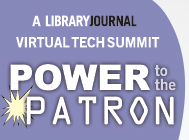 At LJ’s Virtual Tech Summit, “Power to the Patron: From Systems to Services,” held on December 8, librarians and tech experts took on an array of topics facing libraries, including social networking, self-service, mashups using application programming interfaces (APIs), and the future of integrated library systems (ILSs). Library automation company SirsiDynix was a platinum sponsor of the summit, and LJ asked its CEO, Bill Davison, to weigh in on the issues.
At LJ’s Virtual Tech Summit, “Power to the Patron: From Systems to Services,” held on December 8, librarians and tech experts took on an array of topics facing libraries, including social networking, self-service, mashups using application programming interfaces (APIs), and the future of integrated library systems (ILSs). Library automation company SirsiDynix was a platinum sponsor of the summit, and LJ asked its CEO, Bill Davison, to weigh in on the issues.
LJ: At LJ’s Virtual Tech Summit, keynoter Bryan Alexander, senior fellow at the National Institute for Technology in Liberal Education, noted the continuing growth of mobile apps and social networking. At the recent ALA Midwinter meeting, you launched a new Facebook app. How do you see social networking in libraries going forward?
Davison: We see both social and mobile trends as a growing part of the library users’ lives—be it as patrons at public libraries or students at academic libraries. As a solution provider to libraries, it is our responsibility to give our libraries ways to be a part of their users’ lives anywhere, anyhow, anytime. This certainly includes the traditional experience in the library but also, more importantly, as people want to have access to knowledge from outside of the physical library and from each other.
This means we have to give these users tools to access the library from mobile devices, including phones and tablets, and to share their experiences. These interactions add value for the user and for the library. Social networks are places people interact and we want to give our libraries the power to exist and thrive in these economies.
What do you see as driving the growing trend toward self-service technology in libraries?
We see three drivers in self-service adoption: comfort level, convenience, and cost savings.
First, comfort level. Library users first began getting comfortable with self-service as the ILS system began including an OPAC. The OPAC gave users the ability to search the catalog on their own without the assistance of a librarian. The addition of self-service at checkout makes sense as people have become more and more comfortable with the idea. Self-checkout is all over in the retail experience, perhaps most visibly at grocery stores, and this has aided consumers’ comfort level with self-service.
The second driver is convenience. Self-service generally lets people control their experience more fully, very often reducing lines and wait time in the process. In our era of immediacy, users value this in-and-out convenience.
Finally, the third driver is cost savings. Library staff find that they can save expenses related to the number of part-time checkout clerks they need to employ. Typically, in implementing self-service, libraries can move to only one checkout clerk and sometimes none at off-peak hours, letting most people go through the self-check options independently.
At the Tech Summit, John Wohlers of Waubonsee Community College, Sugar Grove, IL, and Monique Sendze of Douglas County Libraries, CO, both SirsiDynix customers, talked about using application programming interfaces (APIs) to create new services. What has SirsiDynix learned from these mashups?
Because of our solution’s broad base of APIs that have been available for years, we’ve learned that our libraries, while basically performing similar functions, can have very unique desires in how to accomplish them. We see our libraries as very creative; they love to have the ability to build the exact applications they want, performing functions unique to their situation. They like to know they can make the solution work the exact way they want, even if no one else does it that way. That autonomy is something SirsiDynix proudly supports.
How has the rise of ebooks altered SirsiDynix’s product development strategy?
Ebooks are an ever-growing additional resource and service that our libraries want to offer their patrons or students. Ereader and tablet adoption has multiplied in the last year alone, and that makes it a priority both for libraries and for us. This means we at SirsiDynix must make e-reading an integral part of our solutions as libraries embrace ebooks more and more.
Meanwhile, we have received overwhelming feedback that the current technology available for delivering ebooks has not been a good experience for users. Library after library has asked us to better integrate the process of searching, seeing an item’s status, and downloading ebooks into the current physical book experience. As a result, we launched a major development initiative we call “eResource Central.” Project eResource Central will take advantage of our vast experience in cloud solutions and provide a much improved and integrated user experience. We are building a cloud-based source of both public domain ebooks and newer releases of ebooks that makes the searching and access seamless to the user, whether in the library, on a mobile device, or in Facebook. We will also offer demand-driven acquisition (DDA) that will remove the risk of acquisition staff trying to predict the ebooks that will be desired and offer the opportunity for users to have some power to choose and access, in real time, on behalf of the library. Expect to see major announcements from SirsiDynix in this area early this summer.
 The archives for LJ‘s December 8 Virtual Tech Summit, Power to the Patron: From Systems to Services, are available online until March 8, 2012. Register at www.thedigitalshift.com/events/tech-summit/.
The archives for LJ‘s December 8 Virtual Tech Summit, Power to the Patron: From Systems to Services, are available online until March 8, 2012. Register at www.thedigitalshift.com/events/tech-summit/.


Self-service checkout may have its place and be welcome in certain library environments, but any call for eliminating paraprofessional (or professional librarian) staff in the name of cost savings is a disservice to our profession and patrons. If you look around many grocery retailers are actually reverting back to live employees in an attempt to regain the person-to-person contact and interaction that was stripped away with self-service checkout. Let’s not make that same mistake.
1. Although I am not really a geek I believve the most powerful API is in the form url + respone type + query string
e.g
http://api.flickr.com/services/rest/?method=flickr.test.echo&name=value
http://xisbn.worldcat.org/webservices/xid/isbn/9789574760442?method=getEditions&startIndex=1&count=2
so you can see what make up the query and what may be retrieved
So how do you consider sd enterprise fits with the URL as API
when an enterprise URL has the elegance like
http://rdg.ent.sirsidynix.net.uk/client/main/q$003dbabbage$0026rw$003d0$0026lm$003dEXCLUDE_LR$0026
or http://rdg.ent.sirsidynix.net.uk/client/main/q$003dbabbage$0026rw$003d0$0026d$003dent$00253A$00252F$00252FSD_ILS$00252F1259$00252FSD_ILS$00253A1259733$00253AILS$00253A3$00253A153$0026lm$003dEXCLUDE_LR$0026
2. I may not be very good at this google thing but I cant find the Sisrsi Dynix Open API documentation
So how can I do a mash up?